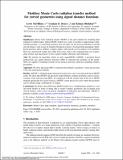Files in this item
Meshless Monte Carlo radiation transfer method for curved geometries using signed distance functions
Item metadata
| dc.contributor.author | McMillan, Lewis Thomas | |
| dc.contributor.author | Bruce, Graham David | |
| dc.contributor.author | Dholakia, Kishan | |
| dc.date.accessioned | 2022-08-05T16:30:03Z | |
| dc.date.available | 2022-08-05T16:30:03Z | |
| dc.date.issued | 2022-08-04 | |
| dc.identifier | 277099216 | |
| dc.identifier | aa2ee1a4-2e17-4310-a87b-5eccb9eed6f0 | |
| dc.identifier | 85135425608 | |
| dc.identifier | 000847803500006 | |
| dc.identifier.citation | McMillan , L T , Bruce , G D & Dholakia , K 2022 , ' Meshless Monte Carlo radiation transfer method for curved geometries using signed distance functions ' , Journal of Biomedical Optics , vol. 27 , no. 8 , 083003 . https://doi.org/10.1117/1.JBO.27.8.083003 | en |
| dc.identifier.issn | 1083-3668 | |
| dc.identifier.other | ORCID: /0000-0003-3403-0614/work/116910151 | |
| dc.identifier.other | ORCID: /0000-0002-7725-5162/work/116910217 | |
| dc.identifier.uri | https://hdl.handle.net/10023/25785 | |
| dc.description | Funding: Funding: The work was supported by funding from the UK Engineering and Physical Sciences Research Council (EP/R004854/1) and the European Union H2020 projects “Dynamic” (EC-GA 863203) and “Proscope” (871212). KD acknowledges support of the Australian Research Council through a Laureate Fellowship. | en |
| dc.description.abstract | Significance: Monte Carlo radiation transfer (MCRT) is the gold standard for modeling light transport in turbid media. Typical MCRT models use voxels or meshes to approximate experimental geometry. A voxel-based geometry does not allow for the precise modeling of smooth curved surfaces, such as may be found in biological systems or food and drink packaging. Mesh-based geometry allows arbitrary complex shapes with smooth curved surfaces to be modeled. However, mesh-based models also suffer from issues such as the computational cost of generating meshes and inaccuracies in how meshes handle reflections and refractions. Aim: We present our algorithm, which we term signedMCRT (sMCRT), a geometry-based method that uses signed distance functions (SDF) to represent the geometry of the model. SDFs are capable of modeling smooth curved surfaces precisely while also modeling complex geometries. Approach: We show that using SDFs to represent the problem’s geometry is more precise than voxel and mesh-based methods. Results: sMCRT is validated against theoretical expressions, and voxel and mesh-based MCRT codes. We show that sMCRT can precisely model arbitrary complex geometries such as microvascular vessel network using SDFs. In comparison with the current state-of-the-art in MCRT methods specifically for curved surfaces, sMCRT is more precise for cases where the geometry can be defined using combinations of shapes. Conclusions: We believe that SDF-based MCRT models are a complementary method to voxel and mesh models in terms of being able to model complex geometries and accurately treat curved surfaces, with a focus on precise simulation of reflections and refractions. sMCRT is publicly available at https://github.com/lewisfish/signedMCRT. | |
| dc.format.extent | 15 | |
| dc.format.extent | 2964973 | |
| dc.language.iso | eng | |
| dc.relation.ispartof | Journal of Biomedical Optics | en |
| dc.subject | Monte Carlo | en |
| dc.subject | Light transport | en |
| dc.subject | Signed distance functions | en |
| dc.subject | Geometry | en |
| dc.subject | Meshless | en |
| dc.subject | QA75 Electronic computers. Computer science | en |
| dc.subject | QC Physics | en |
| dc.subject | QH301 Biology | en |
| dc.subject | DAS | en |
| dc.subject.lcc | QA75 | en |
| dc.subject.lcc | QC | en |
| dc.subject.lcc | QH301 | en |
| dc.title | Meshless Monte Carlo radiation transfer method for curved geometries using signed distance functions | en |
| dc.type | Journal article | en |
| dc.contributor.sponsor | EPSRC | en |
| dc.contributor.sponsor | European Commission | en |
| dc.contributor.sponsor | European Commission | en |
| dc.contributor.institution | University of St Andrews. School of Physics and Astronomy | en |
| dc.contributor.institution | University of St Andrews. Centre for Biophotonics | en |
| dc.contributor.institution | University of St Andrews. Sir James Mackenzie Institute for Early Diagnosis | en |
| dc.contributor.institution | University of St Andrews. Biomedical Sciences Research Complex | en |
| dc.identifier.doi | 10.1117/1.JBO.27.8.083003 | |
| dc.description.status | Peer reviewed | en |
| dc.identifier.grantnumber | EP/R004854/1 | en |
| dc.identifier.grantnumber | 863203 | en |
| dc.identifier.grantnumber | 871212 | en |
This item appears in the following Collection(s)
Items in the St Andrews Research Repository are protected by copyright, with all rights reserved, unless otherwise indicated.

